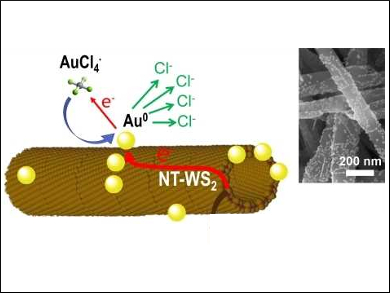Disulfide nanotubes are analogs of the well-known carbon nanotubes (CNTs). However, they have been much less tested in sensing and optoelectronic technologies. The functionalization of disulfide nanotubes is still trickier than for CNTs, and no universal surface activation methods have been found so far.
Alexander Polyakov, Lomonosov Moscow State University, Russia, and colleagues have functionalized WS2 nanotubes (NT-WS2) with gold nanoparticles and evaluated the gas-sensing properties of the resulting nanocomposites. Gold nanoislands (pictured) can be grown onto NT-WS2 by direct interaction of the disulfide with dissolved HAuCl4.
Due to the plasmonic features of gold nanoparticles, the synthesized material can be easily excited by visible light. The gold-decorated nanotubes (Au–NT–WS2) have a remarkable sensitivity to NO2 gas at room temperature under periodical illumination by a 530 nm-light-emitting diode. Au–NT–WS2 possesses a sensitivity in the 0.25–2.0 ppm range of NO2 concentration. The material could, thus, be used in low-power sensors to detect toxic NOx gases.
- Gold Decoration and Photoresistive Response to Nitrogen Dioxide of WS2 Nanotubes,
Alexander Yu. Polyakov, Daniil A. Kozlov, Vasily A. Lebedev, Ratibor G. Chumakov, Alexander S. Frolov, Lada V. Yashina, Marina N. Rumyantseva, Eugene A. Goodilin,
Chem. Eur. J. 2018.
https://doi.org/10.1002/chem.201803502




